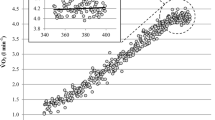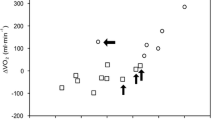Abstract.
The purpose of the present study was to examine comprehensively the kinetics of oxygen uptake (\(\dot V{\rm O}_{\rm 2} \) ) during treadmill running across the moderate, heavy and severe exercise intensity domains. Nine subjects [mean (SD age, 27 (7) years; mass, 69.8 (9.0) kg; maximum \(\dot V{\rm O}_{\rm 2} \) , \(\dot V{\rm O}_{{\rm 2max}} \) , 4,137 (697) ml·min–1] performed a series of "square-wave" rest-to-exercise transitions of 6 min duration at running speeds equivalent to 80% and 100% of the \(\dot V{\rm O}_{\rm 2} \) at lactate threshold (LT; moderate exercise); and at 20%, 40%, 60%, 80% and 100% of the difference between the \(\dot V{\rm O}_{\rm 2} \) at LT and \(\dot V{\rm O}_{{\rm 2max}} \) (Δ, heavy and severe exercise). Critical velocity (CV) was also determined using four maximal treadmill runs designed to result in exhaustion in 2–15 min. The \(\dot V{\rm O}_{\rm 2} \) response was modelled using non-linear regression techniques. As expected, the amplitude of the \(\dot V{\rm O}_{\rm 2} \) primary component increased with exercise intensity [from 1,868 (136) ml·min–1 at 80% LT to 3,296 (218) ml·min–1 at 100% Δ, P<0.05]. However, there was a non-significant trend for the "gain" of the primary component to decrease as exercise intensity increased [181 (7) ml·kg–1·km–1 at 80% LT to 160 (6) ml·kg–1·km–1 at 100% Δ]. The time constant of the primary component was not different between supra-LT running speeds (mean value range = 17.9–19.1 s), but was significantly shorter during the 80% LT trial [12.7 (1.4) s, P<0.05]. The \(\dot V{\rm O}_{\rm 2} \) slow component increased with exercise intensity from 139 (39) ml·min–1 at 20% Δ to 487 (57) ml·min–1 at 80% Δ (P<0.05), but decreased to 317 (84) ml·min–1 during the 100% Δ trial (P<0.05). During both the 80% Δ and 100% Δ trials, the \(\dot V{\rm O}_{\rm 2} \) at the end of exercise reached \(\dot V{\rm O}_{{\rm 2max}} \) [4,152 (242) ml·min–1 and 4,154 (114) ml·min–1, respectively]. Our results suggest that the "gain" of the primary component is not constant as exercise intensity increases across the moderate, heavy and severe domains of treadmill running. These intensity-dependent changes in the amplitudes and kinetics of the \(\dot V{\rm O}_{\rm 2} \) response profiles may be associated with the changing patterns of muscle fibre recruitment that occur as exercise intensity increases.
Similar content being viewed by others
Author information
Authors and Affiliations
Additional information
Electronic Publication
Rights and permissions
About this article
Cite this article
Carter, H., Pringle, J.S., Jones, A.M. et al. Oxygen uptake kinetics during treadmill running across exercise intensity domains. Eur J Appl Physiol 86, 347–354 (2002). https://doi.org/10.1007/s00421-001-0556-2
Accepted:
Published:
Issue Date:
DOI: https://doi.org/10.1007/s00421-001-0556-2




